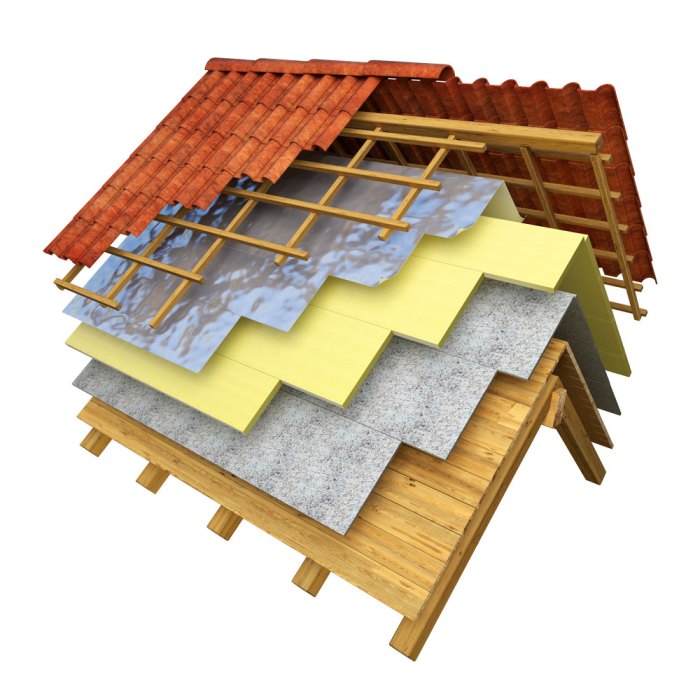Best materials for energy efficient home construction are crucial for minimizing environmental impact and reducing utility bills. This exploration delves into the thermal performance of various insulation materials, the impact of building envelope choices on energy efficiency, and the role of sustainable and renewable materials in creating a truly energy-conscious home. We will examine the benefits and drawbacks of different options, considering factors like R-value, cost, environmental impact, and installation ease, providing a comprehensive guide to building a greener, more energy-efficient dwelling.
From selecting the right insulation for optimal thermal performance to choosing high-performance windows and doors that minimize heat transfer, each decision contributes significantly to the overall energy efficiency of the structure. Understanding the properties of different building materials, including their thermal mass, air leakage characteristics, and reflectivity, is paramount. This guide aims to provide the knowledge necessary to make informed choices, leading to a home that is both comfortable and environmentally responsible.
Insulating Materials
Choosing the right insulation is crucial for maximizing energy efficiency in home construction. Different materials offer varying levels of thermal performance, cost-effectiveness, and environmental impact. Understanding these factors allows for informed decision-making to optimize both energy savings and budget. This section will compare several popular insulation options and discuss proper installation techniques.
Thermal Performance Comparison of Insulation Materials
The thermal performance of insulation is primarily measured by its R-value, which represents its resistance to heat flow. A higher R-value indicates better insulation. The following table compares several common insulation materials based on R-value, cost, environmental impact, and installation difficulty. Note that R-values can vary depending on the thickness and density of the material. Costs are estimates and can fluctuate based on location and market conditions.
Environmental impact considers both manufacturing processes and the material’s lifecycle. Installation difficulty reflects the level of expertise needed for proper installation.
| Insulation Material | R-value per inch | Cost (per unit) | Environmental Impact | Installation Difficulty |
|---|---|---|---|---|
| Fiberglass Batt | R-3 to R-6 | Low to Moderate | Moderate (some fiberglass manufacturing uses energy and produces waste) | Easy |
| Cellulose | R-3.1 to R-3.8 per inch | Moderate | Good (often made from recycled materials) | Moderate |
| Spray Foam (Open-cell) | R-3.6 to R-3.8 per inch | Moderate to High | Moderate (contains some VOCs, but improving) | Moderate to Difficult |
| Spray Foam (Closed-cell) | R-6 to R-7 per inch | High | Moderate (similar to open-cell, but with some added concerns) | Difficult |
| Mineral Wool (Rock Wool/Glass Wool) | R-3 to R-4 per inch | Moderate to High | Good (often made from recycled materials and natural resources) | Moderate |
Vacuum Insulated Panels (VIPs)
Vacuum Insulated Panels (VIPs) are a high-performance insulation option consisting of a core material (like silica aerogel) encased in a vacuum-sealed envelope. VIPs offer exceptionally high R-values (R-10 to R-20 per inch or more) due to the absence of air within the panel. This makes them highly effective in reducing heat transfer. However, their high cost and susceptibility to damage during installation limit their widespread adoption.
VIPs are best suited for applications where space is limited or where exceptional insulation performance is required, such as in high-performance building envelopes or retrofitting existing structures where minimal space is available for insulation. Their fragility necessitates careful handling and installation.
Insulation Installation Techniques
Proper installation is critical to achieving the rated R-value of any insulation material. Improper installation can lead to significant heat loss or gain, negating the benefits of using high-performance insulation. For example, air gaps in fiberglass batts can drastically reduce their effectiveness. Similarly, inconsistent spray foam application can lead to thermal bridging. Detailed installation instructions should always be followed for each specific product.
Professional installation is often recommended, especially for more complex materials like spray foam or VIPs, to ensure optimal performance and avoid potential issues. Key considerations include proper sealing around penetrations (pipes, wires), ensuring continuous insulation layers with minimal gaps, and selecting the appropriate insulation type for the specific application (walls, roofs, floors).
Building Envelope Materials: Best Materials For Energy Efficient Home Construction
The building envelope, encompassing the exterior walls, roof, and foundation, plays a crucial role in a home’s energy efficiency. Its design and construction directly impact heating and cooling loads, influencing both comfort and energy consumption. Selecting appropriate materials and implementing airtight construction techniques are paramount for minimizing energy waste.
Choosing the right materials is crucial for energy-efficient home construction; consider things like high-performance insulation and low-E glass. Even seemingly minor details matter, such as window treatments; for instance, investing in high-quality window coverings like those found at Luxury curtains and drapes can significantly reduce heat loss or gain. Ultimately, a holistic approach encompassing both structural elements and thoughtful interior design choices leads to a truly energy-efficient home.
The choice of exterior wall materials significantly affects a home’s thermal performance and energy efficiency. Factors such as thermal mass, insulation value (R-value), and air leakage susceptibility must be carefully considered.
Exterior Wall Material Impacts on Energy Efficiency
Different exterior wall materials offer varying levels of thermal performance and resistance to air leakage. The following points highlight the key characteristics of common materials.
- Brick: Offers good thermal mass, storing heat during the day and releasing it at night, reducing temperature fluctuations. However, brick’s R-value is relatively low unless significant insulation is added. Air leakage can be a concern if not properly sealed.
- Wood: Relatively lightweight and easy to insulate, wood-framed walls can achieve high R-values with proper insulation. However, air sealing is critical due to the potential for gaps and cracks in framing.
- Concrete: Possesses high thermal mass, similar to brick, helping to moderate indoor temperatures. However, concrete itself has a lower R-value than insulated wood framing, requiring additional insulation to achieve high energy efficiency. Airtight construction is vital.
- Structural Insulated Panels (SIPs): These prefabricated panels combine structural sheathing with insulation, providing excellent thermal performance and high air tightness. SIPs can significantly reduce energy consumption compared to traditional construction methods. They offer a higher R-value and reduced air leakage compared to other materials.
Airtight Construction Techniques, Best materials for energy efficient home construction
Air leakage is a significant source of energy loss in buildings. Maintaining an airtight building envelope is crucial for minimizing drafts, reducing heating and cooling loads, and improving indoor air quality. Effective air sealing techniques are essential at all points of penetration through the building envelope.
- Windows and Doors: Proper installation is key. Use high-quality sealant around frames and gaps to prevent air infiltration. Weatherstripping should be applied to ensure a tight seal.
- Wall Penetrations: Any openings for pipes, electrical wiring, or plumbing should be carefully sealed with appropriate sealant and insulation. Caulk, spray foam, and expanding foam are commonly used for this purpose. Continuous insulation is ideal around these penetrations to minimize thermal bridging.
- Electrical Outlets and Switches: These are common areas for air leakage. Use airtight covers or seal around them with caulk or expanding foam.
High-Performance Windows and Doors
High-performance windows and doors are engineered to minimize energy loss through conduction, convection, and radiation. Their specifications are crucial in assessing their energy efficiency.
Key metrics include the U-factor (heat transfer coefficient) and the Solar Heat Gain Coefficient (SHGC). A lower U-factor indicates better insulation, while a lower SHGC indicates less solar heat gain. The best windows and doors will have low U-factors and SHGCs.
| Window Type | U-factor (BTU/hr·ft²·°F) | SHGC |
|---|---|---|
| Single-pane glass | 1.1 or higher | 0.8 or higher |
| Double-pane glass | 0.3 – 0.6 | 0.4 – 0.6 |
| Triple-pane glass | 0.2 or lower | 0.3 or lower |
| High-performance windows with Low-E coatings | 0.2 or lower | 0.2 – 0.4 |
Roofing Materials
Choosing the right roofing material significantly impacts a home’s energy efficiency. The material’s reflectivity, thermal mass, and the overall design of the roof system all contribute to how effectively it insulates and protects the home from extreme temperatures. This section will delve into the specifics of various roofing materials and their impact on energy consumption.
Roofing Material Comparison: Energy Efficiency
Different roofing materials exhibit varying levels of energy efficiency, primarily due to differences in their solar reflectance (albedo) and thermal properties. High albedo materials reflect more sunlight, reducing the amount of heat absorbed by the roof and subsequently transferred into the building. Materials with high thermal mass absorb heat more slowly and release it more gradually, minimizing temperature fluctuations within the home.
Choosing the right materials is crucial for energy-efficient home construction; consider options like SIPs or ICFs for superior insulation. Even small details matter, such as selecting energy-efficient lighting, perhaps incorporating a beautiful Designer table lamps to complement your eco-friendly design choices, while minimizing energy consumption. Ultimately, the goal is to create a home that’s both stylish and sustainable, minimizing your environmental impact.
The following table summarizes the comparative energy efficiency of common roofing materials:
| Roofing Material | Solar Reflectance (Albedo) | Thermal Properties | Energy Efficiency Rating (Relative) |
|---|---|---|---|
| Asphalt Shingles (Dark) | Low (0.10 – 0.15) | Low thermal mass, high heat absorption | Low |
| Asphalt Shingles (Light) | Moderate (0.20 – 0.30) | Low thermal mass, moderate heat absorption | Moderate |
| Metal Roofing (Light-colored) | High (0.35 – 0.70) | Low thermal mass, high reflectivity | High |
| Tile Roofing (Light-colored) | Moderate to High (0.25 – 0.50) | High thermal mass, moderate heat absorption | Moderate to High |
*Note: Albedo values are approximate and can vary based on color and specific product. Energy efficiency ratings are relative comparisons and do not represent a standardized scale.*
Roof Ventilation and Energy Efficiency
Proper roof ventilation plays a crucial role in preventing heat buildup in the attic space. A well-ventilated attic allows for the escape of hot air, reducing the amount of heat transferred into the living space below. This is achieved through the combination of intake vents at the soffit (low) and exhaust vents at the ridge (high). This creates a natural convection current, drawing hot air out and pulling cooler air in.
Without adequate ventilation, heat can become trapped, increasing cooling loads and energy consumption. A properly ventilated attic can significantly reduce attic temperatures, resulting in lower energy bills and improved indoor comfort. Consideration should also be given to the insulation within the attic space, as this acts as a barrier to heat transfer.
Cool Roofs and Energy Consumption Reduction
Cool roofs are designed to reflect a significant portion of solar radiation, minimizing heat absorption and reducing the cooling load on a building. This is achieved through the use of highly reflective roofing materials, such as light-colored metal roofing or specially formulated cool roof coatings. The benefits of cool roofs include reduced energy consumption for cooling, improved indoor comfort, and extended roof lifespan.
For example, studies have shown that cool roofs can reduce cooling energy consumption by up to 20% in hot climates, resulting in substantial cost savings over the life of the roof. Furthermore, the lower surface temperature of a cool roof can contribute to a reduction in the urban heat island effect, which benefits the surrounding environment. The reduced heat transfer also minimizes thermal stress on the roofing materials, extending their lifespan and reducing the frequency of replacements.
Foundation and Flooring Materials

Source: franzoso.com
The foundation and flooring of a home significantly impact its overall energy efficiency. These elements form a crucial barrier between the interior living space and the often-unpredictable temperatures of the ground and exterior environment. Choosing appropriate materials and employing effective insulation strategies in these areas is vital for minimizing energy loss and maintaining comfortable indoor temperatures year-round.
Foundation Material Thermal Properties and Ground Energy Loss
Different foundation materials exhibit varying thermal properties, directly influencing heat transfer between the interior and the ground. Concrete, a common foundation material, possesses relatively high thermal conductivity, meaning it readily transfers heat. This can lead to significant energy loss during cold winters and increased cooling loads in summer. Insulated Concrete Forms (ICFs), on the other hand, consist of interlocking foam blocks filled with concrete.
Choosing the right materials is crucial for energy-efficient home construction; consider options like insulated concrete forms or high-performance windows. Proper upkeep is just as important, however, and regular maintenance significantly impacts energy efficiency. For helpful advice on this, check out these Home exterior maintenance tips to extend the life of your chosen materials and maximize your home’s energy savings.
Ultimately, the best materials are only as effective as their upkeep.
The foam insulation significantly reduces thermal conductivity, resulting in substantially lower energy loss compared to traditional concrete foundations. Other options, such as poured-in-place concrete with added insulation, also offer improved thermal performance. The choice of foundation material should carefully consider the local climate and energy efficiency goals. A properly designed and insulated foundation in a cold climate, for instance, will drastically reduce the heating load, saving significant energy and money.
Choosing the best materials for energy-efficient home construction is crucial for long-term savings. Factors like insulation and window type significantly impact energy consumption. Interestingly, even the interior design choices, such as selecting pieces from a reputable vendor like High-end furniture shops, can indirectly influence energy efficiency by promoting a comfortable and well-designed space that reduces the need for excessive heating or cooling.
Ultimately, a holistic approach, encompassing both building materials and interior design, is key to maximizing energy efficiency in a home.
Foundation and Crawlspace Insulation and Vapor Barriers
Proper insulation and vapor barriers within the foundation and crawlspace are crucial for minimizing energy loss and preventing moisture problems. Insulation in these areas reduces heat transfer to the ground, preventing cold air from entering the home in winter and warm air from escaping in summer. A continuous layer of insulation is ideal, minimizing thermal bridging – the transfer of heat through less-insulated areas.
Vapor barriers, typically polyethylene sheeting, are strategically placed to prevent moisture from entering the foundation and causing damage or mold growth. In a crawlspace, a combination of insulation and vapor barrier helps to regulate humidity and maintain a stable temperature, reducing energy consumption and protecting the structural integrity of the home. Proper installation of both insulation and vapor barriers is paramount for effectiveness.
Flooring Material Energy Efficiency
The thermal conductivity of flooring materials directly impacts indoor temperature and energy consumption. Materials with low thermal conductivity provide better insulation, reducing heat loss to the ground in winter and preventing heat gain in summer.
| Flooring Material | Thermal Conductivity (W/m·K) | Energy Efficiency Impact |
|---|---|---|
| Concrete Slab (without insulation) | 1.4 – 2.0 | Low; significant heat loss/gain |
| Concrete Slab (with insulation) | 0.1 – 0.3 (depending on insulation type and thickness) | High; reduced heat loss/gain |
| Wood (Hardwood, Engineered) | 0.1 – 0.2 | Moderate to High; good insulator |
| Carpet (with underlayment) | 0.04 – 0.1 | High; excellent insulator |
| Tile (Ceramic, Porcelain) | 1.0 – 2.0 | Low; significant heat loss/gain |
| Laminate | 0.15 – 0.25 | Moderate; better than tile, worse than carpet |
Note: Thermal conductivity values are approximate and can vary depending on specific material properties and manufacturing processes. The impact on energy efficiency also depends on factors such as climate, insulation beneath the flooring, and overall building design.
Sustainable and Renewable Materials
The shift towards energy-efficient construction necessitates the incorporation of sustainable and renewable materials. These materials offer significant environmental benefits, reducing the carbon footprint of buildings and promoting a circular economy. Their use also frequently translates to improved energy performance, lowering operational costs for building owners.Employing sustainable materials goes beyond simply reducing environmental impact; it enhances the overall quality and longevity of a building.
This section will explore the key roles of recycled/reclaimed materials, bio-based materials, and phase-change materials in achieving these goals.
Choosing the best materials for energy-efficient home construction involves careful consideration of insulation and thermal mass. Smart material choices can significantly reduce energy consumption, and this is even more crucial in smaller homes where maximizing space is key. For example, effective space utilization is paramount, which is why exploring options like those found on this helpful resource regarding Small space storage solutions can greatly benefit your design.
Ultimately, the right materials contribute to both energy efficiency and a comfortable living space, regardless of size.
Recycled and Reclaimed Materials in Energy-Efficient Construction
Using recycled and reclaimed materials significantly reduces the demand for virgin resources, minimizing the energy consumption associated with their extraction and processing. Examples include recycled steel for structural components, reclaimed wood for flooring or interior features, and recycled glass for insulation. The environmental benefits are considerable, ranging from decreased greenhouse gas emissions to reduced landfill waste. Furthermore, the embodied energy—the total energy consumed in the material’s life cycle—is significantly lower compared to newly manufactured materials, leading to improved overall energy performance of the building.
For instance, using recycled steel reduces carbon emissions by approximately 70% compared to using new steel. The thermal performance of reclaimed materials can vary depending on their origin and condition, but proper assessment and preparation can ensure they meet required standards.
Bio-Based Materials in Sustainable Home Building
Bio-based materials, derived from renewable plant sources, offer excellent thermal properties and a low environmental impact. Straw bales, for example, possess exceptional insulation capabilities due to their high porosity and air content. Their natural structure traps air, providing effective resistance to heat transfer. Hempcrete, a mixture of hemp fibers and lime, offers similar thermal performance along with good compressive strength.
These materials are readily available, often locally sourced, reducing transportation costs and emissions. The construction process using these materials is often less energy-intensive than traditional methods. For instance, a study conducted by the University of Bath found that hempcrete buildings can have a 50% lower carbon footprint compared to traditional concrete structures. However, it is crucial to consider appropriate moisture management techniques when using these materials to prevent potential issues with rot or mold.
Phase-Change Materials (PCMs) for Improved Thermal Comfort and Energy Efficiency
Phase-change materials are substances that absorb or release significant amounts of latent heat during a phase transition, typically between solid and liquid states. This unique property allows PCMs to buffer temperature fluctuations within a building, maintaining a more stable and comfortable indoor environment. PCMs are incorporated into building materials like wall panels or insulation systems. When the ambient temperature rises, the PCM absorbs heat, preventing it from entering the building.
Conversely, when the temperature drops, the PCM releases stored heat, mitigating heat loss. This thermal buffering effect reduces the load on heating and cooling systems, resulting in significant energy savings. For example, the incorporation of PCMs in wall insulation can reduce heating energy consumption by up to 15%, depending on the climate and building design. Common examples of PCMs used in construction include paraffin waxes and salt hydrates.
The effectiveness of PCMs depends on factors like their melting point, latent heat capacity, and the overall building design.
Last Point
Building an energy-efficient home requires careful consideration of numerous factors, from the selection of insulation and building envelope materials to the choice of roofing, foundation, and flooring. By prioritizing materials with high thermal performance, low environmental impact, and effective air sealing, we can significantly reduce energy consumption and create a sustainable living environment. This guide highlights the importance of informed decision-making, emphasizing the long-term benefits of investing in energy-efficient construction practices.
Ultimately, creating a comfortable, sustainable home begins with selecting the right materials, and this understanding empowers homeowners and builders alike to make choices that positively impact both their finances and the planet.
Essential Questionnaire
What are the best insulation materials for a cold climate?
Spray foam insulation offers superior performance in cold climates due to its high R-value and air-sealing capabilities. However, mineral wool and cellulose are also viable options depending on budget and environmental concerns.
How important is air sealing in energy efficiency?
Air sealing is critical. Air leaks account for a significant portion of energy loss. Proper sealing around windows, doors, and penetrations is crucial for maximizing energy savings.
Are there any downsides to using sustainable building materials?
While sustainable materials offer environmental benefits, some may have higher initial costs or require specialized installation techniques. Availability can also be a factor depending on location.
How can I choose energy-efficient windows?
Look for windows with low U-factors (indicating low heat transfer) and high solar heat gain coefficients (SHGC) for optimal performance. Consider low-E coatings and gas fills for added insulation.
What is the role of thermal mass in energy efficiency?
Materials with high thermal mass, like concrete or brick, absorb and release heat slowly, helping to moderate indoor temperatures and reduce energy demand for heating and cooling.


